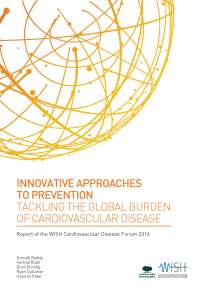 Cardiovascular disease (CVD) causes 17.5 million deaths each year. Most of these deaths are from heart attacks and strokes, and many are premature. Although outstanding progress has been made in CVD awareness, prevention and treatment, three out of every 10 deaths this year will still be result of CVD.
Cardiovascular disease (CVD) causes 17.5 million deaths each year. Most of these deaths are from heart attacks and strokes, and many are premature. Although outstanding progress has been made in CVD awareness, prevention and treatment, three out of every 10 deaths this year will still be result of CVD.
A global epidemic, cardiovascular disease is the leading cause of mortality and morbidity worldwide, affecting all regions regardless of income. Low-and middle-income countries make the largest contribution to the burden of CVD, particularly in terms of deaths in people aged 30 to 70 years, and those figures are still rising. However, CVD deaths and disability are not inevitable and up to a quarter could be avoided with more effective strategies for primary and secondary prevention. The ‘what’ is well-known, with a range of well-established, evidence-based and effective interventions. But knowing what to do has not proved enough to ensure effective implementation at scale. The ‘how’ still eludes us in some areas, and for some populations.
Discussed at this morning’s World Innovation Health Summit panel discussions, this report focuses on the role of innovative delivery models to extend the reach, accelerate the uptake and increase the impact of the most effective interventions. It provides clarity for policymakers on which areas to prioritise to achieve the most substantial reduction in CVD burden over the next 10 to 15 years, namely: hypertension diagnosis and management, tobacco control and effective secondary prevention.
The report identifies five levers that health systems can use to extend CVD prevention to remote places, underserved segments of society, and future generations: regulatory intervention; workforce innovation; digital, patient-centred technologies; public health intelligence; and behavioural economics. it highlights how many of these efforts are complementary to each other and are not expensive to implement.
In their research the authors draw on case studies of programmes in Brazil, South Africa, India, the UK and Bhutan. The report focuses on the role of innovative delivery models in these countries that have succeeded in extending the reach, accelerating the uptake and increasing the impact of the most effective interventions.
Report insights
To meet the World Heart Federation (WHF) goal of reducing CVD mortality globally 25 percent by 2025, health systems would have to reduce prevalence of hypertension by 25 percent, reduce daily tobacco use by 30 percent, and provide secondary prevention to more than 50 percent of the eligible population.
While no country has yet achieved this ambitious goal, the report offers a roadmap for policymakers on this journey. it provides clarity for policymakers on which areas to prioritise to achieve the most substantial reduction in CVD burden over the next 10 to 15 years, namely: hypertension diagnosis and management; tobacco control; and effective secondary prevention.
It offers innovative approaches to accelerate the implementation of policy levers and offers suggestions on how to deploy limited resources most effectively. Finally, it proposes a strategic framework to guide the sequencing of policy at the national level to create impact.
Further Reading
Read the full report here.
Read all the WISH forum reports here.
About the World Innovation Summit for Health (WISH)
WISH focuses on some of the most pressing global health challenges facing governments, health systems and populations. WISH brings together internationally renowned experts, who work with advisory groups to publish evidence-based reports on a range of healthcare topics each year.
Chaired by a team of experts drawn from academia, industry and policymaking, the WISH Forums look in depth at the challenges faced in each area – surveying the literature and interviewing experts in the field. The Forum reports present some of the very best innovations that have been shown to have real impact across the developed and the developing world.
During the Summit, the Forum reports will form the basis of a series of panel discussions hosted by leading experts. The Chair of each Forum will open the panel discussion, focusing on ways key issues can be tackled and considering some of the available innovations that might help.
For further information about WISH and previous conferences, visit their website.
